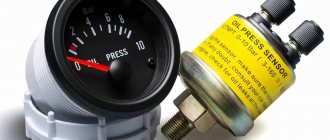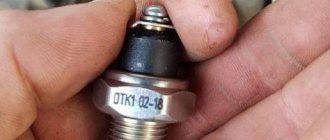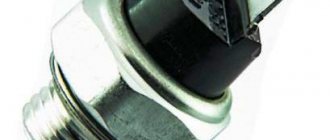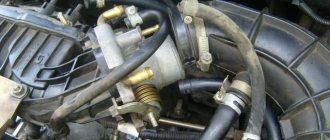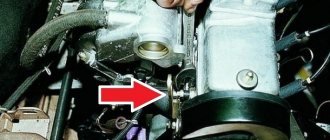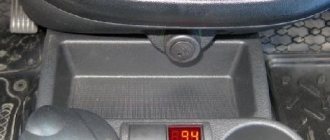The ODM (Oil Pressure Sensor) on the Lada Grant, like on any other car, is designed to signal the driver about the oil pressure in the engine. If it falls, the sensor will report this to the BC and the corresponding information will be visible on the dashboard display or on-board computer.
But sometimes it happens that the oil pressure warning light comes on, but the oil level and pressure are normal, and the reason is a malfunction of the oil pressure sensor.
➤ Self-replacement of the oil pressure sensor on Lada Vesta
Owners of a Lada Vesta with a VAZ 21179 (1.8 l) engine are faced with the fact that the oil pressure indicator does not go out for a long time when starting the engine. Or the diode does not light up at all.
Many car enthusiasts panic about this, saying they need to change the oil, undergo maintenance, etc. Do not rush to go to extremes; most likely the cause is the emergency oil pressure sensor (hereinafter referred to as EBP). The process of self-replacement is not complicated, but requires care on the part of the repairman.
Procedure for replacing the oil pressure sensor on a Lada Vesta yourself
- Turn off the engine;
- Open the hood;
- Wait until the engine cools down so as not to damage the skin of your hands;
- Remove the block with wires from the DBP, which is located on the left in the direction of travel, behind the oil filler neck;
- Using the key “19”, unscrew the old controller;
- Wipe the seat with a rag;
- Screw in the new controller;
- Put on the block with wires;
- Start the engine and check the oil pressure.
Where is DBP located?
Lada Vesta, as well as X-Ray, is equipped with two modifications of gasoline engines:
- 8 liter 16 valve (122 hp);
- 6 liter 8 valve (109 hp).
Both versions have the same oil pump pre-installed. Obviously, in engines with a large volume, the pump wears out faster, since according to its technical characteristics it is not designed for heavy loads.
Engine oil volume is 1.6 liters. 3.4 liters, in the version with a 16-valve mechanism - 4.5 liters.
- The standard location of the DBP is on the left in the direction of travel of the car, behind the oil filler neck.
| Symptoms of a problem | Causes |
| On-board computer system error P0523 on the dashboard | Loose contact of DBP terminals |
| After starting the engine, the emergency oil pressure lamp stays on for a long time. | Low engine pressure |
| When starting the engine, the emergency engine oil pressure indicator on the instrument panel does not light up. | The electrical circuit of the on-board power supply is damaged |
Replacing the emergency oil pressure sensor with your own hands
Preparation of the workplace, necessary tools:
- Key, head on “19”;
- Rags;
- Additional lighting (optional);
- New pressure controller.
- Regulations:
- We place the car on a flat area;
- We turn off the engine;
- Open the hood;
- We wait until the power unit cools down so as not to damage the skin of the hands;
- Remove the block with wires from the DBP;
- Using the key “19” we unscrew the controller from its regular place;
- We carry out troubleshooting of the seat;
- We screw in the new controller;
- We put on the block with wires;
- We start the engine and check the serviceability of the sensor.
Review of Manufacturer Prices
| Name / catalog article | Price in rubles |
| 11180382901003 | From 650 |
| Fram 2656534154(1) (Lada Vesta 1.6) | From 500 – 550 |
| *prices are as of 05/01/2019 |
Conclusion
Replacing the oil pressure sensor in a Lada Vesta car yourself is not difficult. The task is within the power of every car enthusiast. If any difficulties arise, contact service station specialists for help. Follow safety precautions and do not start work “hot”. When purchasing spare parts, carefully check the catalog numbers with the data specified in the instruction manual.
Reviews
| № | Positive |
| 1 | Petr (autodrome): there are no complaints about the functionality of the DBP, they work in normal mode, the mileage is 34,500 km. |
| 2 | Vyacheslav (autotopic): I tightened the fastening of the terminal on the DAD once, did not contact the service center, managed it on my own. |
| 3 | Victor (Autoreview): the emergency warning diode goes out within 2 seconds after the engine starts. The workshop assured that this is the norm. |
| 4 | Kirill (Avtoria): the car is four years old, mileage 55,000 km, no repairs. I regularly visit service stations and fill them with high-quality fuel and oils. |
| 5 | Alexander (Drom): there have been no critical comments on the operation of the machine for three years; minor breakdowns were eliminated on my own. |
| 6 | Stanislav (Driving): mileage 60,000 km, no rude comments. |
| 7 | Stepanovich (“5th wheel”): my positive review of the Lada Vesta, the car is good, the build quality is above average. For domestic transport it is quite tolerable. |
| Negative | |
| 8 | Vitaly (autotopic): I replaced the DBP for the first time in the third year of the car’s life, fortunately the repair was free of charge, under warranty. |
| 9 | Mikhail (otzovik.net): I heard about the problem with the 1.8 liter oil pump, it is weak for such a volume. |
| 10 | Stanislav (ProAvto): the car constantly breaks down, something breaks, it doesn’t work properly. |
Video - Sensor malfunction
Source: https://remont-avtovaz.ru/lada-vesta-oshibka-r0523-i-davlenie-masla-v-dvigatele/
Replacing the oil pressure sensor on Grant 16-valve
The emergency oil pressure sensor is installed on 16-valve Lada Granta engines on the right side, and is located directly on the cylinder head. To make it clear where to look for it, below is its visual location in the photo.
To make it even clearer, there is one green wire going to it.
So, the emergency oil pressure sensor itself on Grant is needed in order to signal a sound signal and the warning lamp on the instrument panel during a drop in pressure in the system.
If suddenly, while driving or idling, the warning light comes on, you must immediately turn off the engine.
You can start the engine in the future only after determining the reason for the operation of this alarm.
If the cause is a failure of the sensor itself, then everything can be fixed here as quickly and inexpensively as possible. We buy a new one and install it in its original place, replacing the faulty one. To perform this procedure, you must use the following tool:
- Ratchet handle or crank
- Extension
- 21 socket or similar spark plug
Procedure for replacing the oil pressure sensor on a 16-valve Grant
The first step is to disconnect the power wire from the sensor, as shown in the photo below, after pressing the block on both sides, thereby releasing it from the latches.
Then use a 21 mm socket to unscrew it:
When it spins freely, you can finally turn it out by hand.
As you can see, everything is done elementary and simple. Now we take a new sensor and make a replacement, installing it in its original place to replace the failed one. The price of a new part is only 118 rubles for AvtoVAZ production, and even cheaper, about 100 rubles for the Pekar brand.
The sensor must be tightened with a certain torque, which ranges from 24 to 27 Nm.
Source: https://zarulemvaz.ru/zamena-datchika-davleniya-masla-na-grante-16-klapanov/
Operating principle and design of the sensor on the VAZ-2110
The diagram of this element is in our article. The oil pressure sensor consists of several parts:
- Movable and fixed contact.
- Housing (as a rule, it is made of metal).
- Membranes.
- Pusher (moving contact rod).
The “ten” has a contact-type sensor. It is connected directly to the warning light on the instrument panel. After turning on the ignition, a plus from the on-board network is supplied to one of the lamp contacts. As for the second contact, it interacts with the moving element of the meter. How does the sensor work on a VAZ-2110 car? The scheme of operation is quite simple. The sensor's operating algorithm is based on connecting the lamp terminals to ground. A moving contact is responsible for this, through which the pusher is connected to the diaphragm. The cavity located above the diaphragm is in contact with the lubrication system in the engine block. As the pressure inside increases, the force on the diagram increases. The latter begins to bend, thereby moving the movable contact away from the stationary one. If there is no pressure, the contacts will be closed. Accordingly, the red light on the instrument panel will light up. As soon as the pressure in the system rises above a certain level (0.3 atmospheres), the circuit opens. The lamp stops lighting on the instrument panel.
Replacing the oil pressure sensor Lada Granta
An oil pressure sensor, or simply DDM, is a signaling device for the driver that displays the level of oil pressure in the engine. It usually turns on when the level drops noticeably. However, this element may also fail.
Replacing the Grant oil pressure sensor is a process that does not require phenomenal knowledge. You need to have a few tools and instructions on hand.
The DDM consists of three elements:
- Protective housing;
- Measuring membrane;
- Transmitting element.
Operating principle of DDM
The operating system is simple - under oil pressure, the measuring membrane changes position and, as a result, the contacts open or close. When the liquid level drops, the membrane falls, thereby disconnecting the contacts.
After which a signal is triggered and displayed on the dashboard. If the oil pressure sensor on a Lada Granta fails, but the oil level is normal and the entire system, after testing, turns out to be operational, then it is recommended to check the meter itself.
Advice! If you haven’t looked under the hood of your car before and haven’t done at least a little repair and technical work, then you shouldn’t move on to the next stage. Despite the fact that the replacement process is very simple, you can damage the car due to lack of experience.
Location and replacement of the oil pressure sensor on Grant
If you have problems with the DDM or its location ( where the oil pressure sensor is located on the grant ), then the initial task is to find it. In order to get to it, you will need: a ratchet handle, a 21mm socket or equivalent, and a pressure gauge (optional).
The first step is preparation for work. Remove the plastic panel from the engine and on the right side find the required Grant 8 valve oil pressure sensor. It is screwed into the head of the cylinder block (cylinder block). Firmly squeeze the clamps and remove the block. We unscrew the sensor using tools (spanner or open-end wrench 22).
About the sensor
The Granta oil pressure sensor is a small part with a ball inside, which, under the influence of oil pressure in the engine, opens the contacts on the sensor. When you turn the ignition key, the oil pressure light on the instrument panel should light up, and as soon as the car engine starts, the warning light should go out within a few seconds or go out immediately. This indicates sufficient oil pressure in the system and allows the vehicle to be used for its intended purpose. But if the lamp does not go out and is constantly on, this is a reason to turn off the engine and think about solving this problem.
Replacing the oil pressure sensor on Lada Kalina
Most car owners do not fully understand what the oil pressure sensor installed on the Lada Kalina is. After all, as practice shows, car owners do not often look at the special booklet attached to the car when purchasing it, so often many do not even suspect what this or that symbol on the dashboard indicates.
Most often, owners of a Lada Kalina with an 8-valve engine have to get acquainted with the DDM after the pressure indicator on the panel lights up and does not go out for a long time. This, of course, should alert any driver.
Having discovered a burning indicator, one part of car owners will rush to seek help from a service station, while the other decides to solve the problem themselves. Let's try to figure out why the indicator lights up and how
The oil pressure sensor on Kalina is being replaced step by step.
However, before we begin to consider the main issue, we should understand what exactly caused the indicator to light up. After all, experts say that the light actually indicates a critical oil level in the system.
But, on top of everything else, the indicator may not go out for a long time even if the sensor itself has failed.
Do not start work without finding out the reason for the indicator light. This can greatly worsen the technical condition of the car and lead to more serious problems during operation.
What elements does DDM consist of?
First of all, you need to figure out what components the sensor consists of.
So, the device in question includes the following elements:
- protective housing;
- measuring membrane;
- transmission mechanism.
Having understood the components of the device, it will be much easier to understand the principle of its operation.
What is the work of DDM based on?
After turning on the ignition, the membrane will begin to bend, occupying a certain position. Exactly what position the membrane will take depends on the pressure currently available inside the oil system. Occupying the desired position, the membrane closes the electronic contact or, on the contrary, opens it.
Before you start checking the operation of the sensor, you must make sure that the oil filter and oil level are normal. It is equally important to analyze whether there are any streaks on the surface of the engine. If the above symptoms are not detected, you can begin to check the serviceability of the pressure sensor.
Lada Kalina or Lada Granta: which is better according to the owners
Step-by-step verification
Pressure-related devices are checked using a special pressure gauge. The components must be installed in place of the DDM and the car engine must be started.
If the pressure gauge displays 0.65 kgf/cm2 at idle, we can safely say that the sensor is working normally and the pressure is within normal limits.
If the device displays a reduced reading, you will have to replace the oil pressure sensor.
You can check the serviceability of the DDM in another way, that is, without the help of a pressure gauge. After all, it may happen that the indicator lights up while driving. In such circumstances, car owners need to do the following:
- Initially, the sensor is unscrewed from the “socket”;
- next you need to start spinning the starter without starting the engine;
- if oil begins to appear from the “socket” when the starter rotates, this factor will indicate a sensor malfunction.
Under no circumstances should you operate a car without replacing a faulty DDM. After all, all components in the car must work properly; this is important from a safety point of view.
Self-replacement
Replacing a faulty oil pressure sensor yourself is quite simple, following the step-by-step instructions:
- To work, you need to prepare a car key for 21.
- First of all, carefully remove the protective cover from the engine.
- Next, you should pay attention to the reverse side of the engine, since the sensor is screwed into the cylinder head “socket” located on the right.
- By pressing the latches, the holding pads must be disconnected from the pad.
- Unscrew the sensor from the “socket” using a key.
- A new sensor is installed in place of the old, failed one. Before installation, carefully wipe the surface of the “nest” with a clean cloth.
- At the last stage, check the reliability of all installed components, fix the protective cover and check whether the problem has been corrected.
If after starting the engine the indicator goes out after a few seconds, this fact will confirm that the light came on precisely because of a malfunction of the oil pressure sensor.
As you can understand, the process of replacing the DDM is quite simple and understandable, so any Lada Kalina car owner can handle such work. If difficulties arise during the replacement process, you should watch the video instructions prepared by professionals at any time.
Source: https://ladaautos.ru/lada-kalina/zamena-datchika-davleniya-masla-na-lade-kalina.html
About LADA car sensors and engine management system
12 October 2015 LadaOnline 159 004
Various sensors are responsible for the operation of all systems of a modern car. They take readings and transmit them to the electronic engine control unit (ECU). If the sensor malfunctions, an error is stored in the memory, and in some cases a Check Engine error appears on the instrument panel.
Where are the sensors located?
All modern Lada cars (Granta, Kalina, Priora, Vesta, Largus, Niva or Lada XRAY) are equipped with domestic VAZ engines. The location of the sensors on these motors is the same:
Elements of the electronic engine control system of the VAZ 11186/11189: 1* – controller; 2* – crankshaft position sensor; 3* – control oxygen concentration sensor; 4* – diagnostic block; 5* – diagnostic oxygen concentration sensor; 6 – throttle control unit; 7* – vehicle speed sensor; 8* – adsorber purge valve; 9* – gas pedal module; 10* – brake signal switch; 11* – clutch pedal position sensor; 12 – battery; 13 – mass air flow sensor; 14 – coolant temperature sensor; 15 – ignition coil; 16 – knock sensor; 17 – spark plugs; 18* – nozzles. *The item is not visible in the photo.
Engine of the old modification 11183
Engine 11183 is installed on the Standard Grant. It migrated here from the Kalina car. The unpretentious and time-tested engine is quite reliable and does not raise any questions. Its power is quite enough for city driving. Such an engine is less suitable for the track, but Grant will have quite good luck. This engine also has advantages - its elasticity. Unlike the Kalina engine 1.4l 16kl. from the very bottom he begins to accelerate the car well.
This important sensor is located behind the engine air filter. It is also called an air flow meter. Its purpose is to estimate the amount of air entering the car engine. Based on the information received from the sensor, the electronic control unit (ECU) calculates the required amount of fuel to maintain the stoichiometric fuel-to-air ratio for the given engine operating conditions.
Error 0523 Lada Granta - Autognostics
The ODM (Oil Pressure Sensor) on the Lada Grant, like on any other car, is designed to signal the driver about the oil pressure in the engine.
If it falls, the sensor will report this to the BC and the corresponding information will be visible on the dashboard display or on-board computer.
But sometimes it happens that the oil pressure warning light comes on, but the oil level and pressure are normal, and the reason is a malfunction of the oil pressure sensor.
Operating principle of the oil pressure sensor and checking it
The operating principle of the DDM is quite simple - depending on the oil pressure, the measuring membrane inside the sensor bends under the oil pressure and closes and opens the contacts. If the engine oil level drops, the contacts open accordingly and the oil pressure warning light comes on.
Before checking the sensor, make sure that:
If everything is in order with the oil level and filter, you need to check the sensor circuit and itself.
- We check the circuit from the sensor to the warning lamp. Disconnect the terminal from the sensor and lean it against ground. If the circuit is working properly, the oil pressure lamp should go out. If not, there may be a break in the circuit somewhere.
- If after removing the DDM it is in oil, then it is faulty and requires replacement; if the sensor is dry, the reason is in the oil filter, oil level or oil pump.
- You can also check the oil pressure in the engine using a pressure gauge. To do this, unscrew the sensor and screw in the pressure gauge. Start the engine and at idle speed the pressure gauge should show 0.65 kgf/cm2 or more, which means the pump and everything else is fine. The sensor just needs to be replaced.
If your vehicle is equipped with an on-board computer, a P0523 (Oil Pressure Sensor High Voltage) error will appear if the ODM malfunctions. This error indicates that the sensor needs to be replaced.
Where is the sensor located and its part number
The DDM is located on the right side of the engine and is screwed into the cylinder head. To replace it, you will need to remove the plastic decorative cover, after which the sensor will be immediately visible. Replacing the sensor itself is very simple, unscrew the old one and install the new one, no additional actions need to be performed.
The article number of the original oil pressure sensor is 11180-3829010-00 . Its cost may vary in different regions, but on average it ranges from 120 to 160 rubles.
Replacing the sensor yourself
- We remove the decorative plastic protection and put it aside so that it does not interfere
- Carefully squeeze the clamps and remove the block from the sensor
- Using a spanner or open-end wrench set to “21”, unscrew the sensor.
- Now we will examine it and diagnose it according to the points that we described above.
We screw in the new sensor, connect the wire block and start the engine.
If the oil pressure light goes out, then the problem was in the sensor; if not, then you need to look for the cause further.
Source: https://avtognostika.ru/lada/oshibka-0523-lada-granta
Operating principle of DDM
The design part of the DDM is very simple: depending on the force of movement of the technical fluid, the indicating membrane inside the device bends and connects or breaks the contacts. When the technical fluid level decreases to a critical level, the contacts on the device open, which is indicated by a warning lamp on the car’s dashboard.
However, it happens that the control check on the device lights up, but a sufficient amount of technical fluid is indicated on the dipstick. In this case, you need to check the functionality of the oil pressure sensor - most likely the part has failed.
The part number in the manufacturer's catalog is 11180-3829010-00. The average cost of a part on the Russian market is 130-160 rubles. Remember, timely replacement of the oil pressure sensor will allow the engine to serve its entire service life without problems - do not skimp on this problem.


